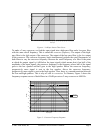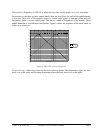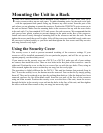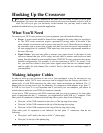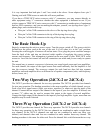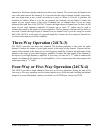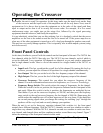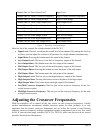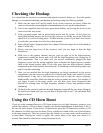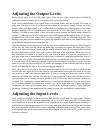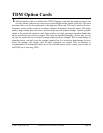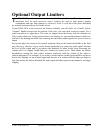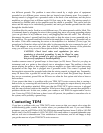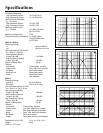
© 2003 TDM Audio, Inc. Electronic Crossover Owner’s Manual Page 21
is the cause of the distortion. If none of the signal processing units in the chain is causing the
distortion, then either it is present in the signal source, or there is a problem with your speaker
system, amplifiers, or crossover.
If you determine that the TDM 24CX series crossover is the cause of a distortion problem, make
sure that the unit is plugged into a proper power source. Read the back panel of the unit for the
correct supply voltage and frequency (US models are set up for 110 VAC at 60 Hz). Using a unit
designed for 220 volt operation with a 110 volt outlet can cause distortion.
One of the most common causes of distortion is improper gain staging. That means that some
piece of equipment is operating at much lower than unity gain (the signal coming out of it is a lot
lower than what is being fed in). Under these conditions, there is often some piece of equipment
that must provide a very hot signal output to compensate. This can cause distortion in the output
stages of this unit, or in input stages of the unit that it is driving.
If the unit is plugged into the correct power source, the signal feeding the unit is clean, your gain
staging is normal, and you are still getting distortion, contact your vendor, or call TDM for
support and/or service (see Contacting TDM).
Excessive Noise
TDM 24CX series crossovers have an excellent signal to noise ratio. If you hear excessive noise
in your system, try to determine its origin systematically. Remove each piece of processing gear
from the signal chain one at a time until you hear the noise go away. If none of the signal
processing units is the cause of the noise, then the noise is probably present in your signal
source.
If you suspect that the TDM 24CX series crossover is the cause of your noise problem, make
sure the unit is plugged into the correct power source. Read the rear panel of the unit to
determine the correct voltage and frequency (US models are set up for 110 VAC at 60 Hz). Using
a unit designed for 220 volt operation plugged into a 110 volt outlet can cause very noisy
operation of the unit.
Make sure your gain staging is correct. If some unit in your system is running at a very low gain,
or if your signal source is weak, you may be running some other unit at a very high gain to
compensate. Some audio equipment produces excessive noise when running at gain levels higher
than unity.
If you check all of these possible causes and you still can’t resolve the problem, contact your
vendor, or call TDM for support and/or service (see Contacting TDM).
60 Hertz Hum or Buzz
60 Hertz hum or buzz in a system can be extremely difficult to track down because it is usually
not a problem with any one piece of equipment. It is usually caused by how the entire system is
connected and grounded.
To fix a hum or buzz in a system, suspect any piece of equipment that gets a ground connection
from more than one place. These problems are called “Ground Loops” and the technical
explanation of why they cause problems is that there is actually a voltage difference between the



